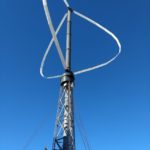Addition – The U.S. is not the only nation on the planet and the air and ocean are connected – the more nations that work towards cleaner air and more sustainable energy sources the better for everyone.
Building windmills to clean the air may be a job for Don Quixote – an impossible task or imaginary one but new creations are imaginary until they are tried in prototype and then replicated. The above images are of a windmill (VAWT) that didn’t work right, unfortunately for investors, but the memory of its design led to a new creation in my imagination for the purpose of powering a giant air filter for cleaning urban smog.
*Note my ideas are simply brainstorming ideas offered in case they might stimulate creative solutions by others working in the area of sustainable energy or clean air – the planet needs both. Inventions generally go through many stages from early brain storming, through a model size prototype or two to a fullsize prototype with revisions as needed. I grew up with a mechanical engineer discussing various ideas and drawing blueprints or showing the family finished blueprints occasionally. Family members occasionally helped with testing gadgets for wind resistance factors – ie – read the numbers on this odd gadget out loud so they can be recorded for later calculations. (a three blade windmill blueprint drawing of the finished outline)(10 nontraditionally shaped windmills/wind turbines) Our planet needs species that use resources in a sustainable way or else the environment becomes depleted and the species dies out if it cannot move to a new area.
Giant air filters/purifiers have been tried successfully and unsuccessfully in other areas.
China created a large air purifier that didn’t work well enough for the size of the problem (the sky is large) (qz.com) but an inventor there has created another one which is in the initial experimental phase of development (South China Morning Post/air purifying tower). So far the new tower air purifying system seems to be more successful at reducing urban smog levels then the previous attempt. The experimental tower is over 100 meters (328 feet) tall and seems to be reducing smog levels in the surrounding ten square kilometer (3.86 square miles) radius around the air purifying tower. It is producing an estimated 10 million cubic meters (353 million cubic feet) of clean air per day. Air is drawn into glass greenhouses that cover about half a soccer field at the base of the tower, the warming effect of the glass houses heats the air and causes it to rise within the tower which contains many layers of cleaning filters. The previous attempt at a giant air purifier did improve air quality but in a smaller radius around the unit. (qz.com)
The Dutch have developed a tube like air filter to place on top of buildings and it cleans like a vacuum cleaner, taking in smog filled air from a radius of 300 meters and from up to seven kilometers (four miles) above it and blowing clean air out the other end of the tube. (TheGuardian)
Smog is a significant problem in many areas in urban areas of China and elsewhere. The nation set more stringent standards for coal use and factory production in a five year plan that began in 2013 to try to improve air quality. The nonprofit environmental group Greenpeace review of air quality suggests that improvements have occurred in urban areas but there may be less change in other areas where factory production has led to increased ozone output. Ozone in excess quantities may increase risk for strokes and heart disease. (South China Morning Post/Greenpeace)
My tilting at windmills idea combines wind power and solar power to try to make a sustainable air purifying tree shaped unit that also helps draw in and push out air across a wide region (the sky is really large). Picture the windmill in the images as spinning with kite like or somewhat pinwheel like flexible solar fabric sails attached to the spiral shaped blades. A rotating windmill would catch breeze from any direction and convert it into power. The solar fabric on the spinning blades would catch sunshine from whatever angle it was shining and convert it into power. The power generated could help pull the smog filled air in to be cleaned at the base of the tower/tree trunk/post or push out the clean air at the top once it had been cleaned within air filter located in layers going up the tree trunk.
My idea was based on a tree as I am more familiar with botany than with windmill or air purifying technology and I hadn’t read about the Chinese attempts at giant air purifiers but have seen tree like wind power or solar power generating units with leaf like solar panels arranged on a branching tree trunk – decorative for an urban area while also generating power. In Singapore giant solar trees have various functions including generating solar energy, supporting flowering plants, and collecting air and dispersing it for reducing heat. (Wind Trees/Paris) (Israeli design Solar Tre/France) (Solar Trees/Singapore)The Chinese experimental tower with the glass houses at the base is using solar energy passively by drawing in the unclean air at the base and allowing the solar heat trapping effect of glass greenhouses to heat it and hot air naturally rises upwards which if directed into a narrow smokestack like tower would force it up through the air filters.
Air flow will also tend to move upwards when there is larger amounts flowing in at the base and a smaller opening at the top so the half a soccer field size of greenhouses moving air up through a small smokestack shaped tower are also capitalizing on that principle of air flow. The large air intake at the base and small outflow at the top increases upward flowing air pressure. Having an upward and downward circulation of air was what I visualized in my idea, with larger intakes at the base forcing upward to a smaller opening at the top which the spinning blades of the windmill would help push out over a large region around the air filtering tree shaped solar windmill.
Creative use of natural wind and airflow patterns was used effectively in a building designed for the Manitoba, Canada area which gets windy. See: Chapter 7 for a discussion of the creative ventilation system designed by Kawabata, KPMB Architects, for Manitoba Hydro, p157, Ch. 7, Creating Great Choices: A Leader’s Guide to Integrative Thinking, by J Riel & R. Martin. HBR.org/Creating Great Choices eBook./pdf,
The solar trees in Singapore have multiple functions that beautify and clean and cool the environment and the building design in Manitoba also supports employee and customer comfort in many ways. Citizen and employee wellness can lead to less lost time due to illness and reduce turnover rate for employees seeking better quality of life or sense of purpose. A discussion of the value of addressing many aspects of quality of life for a business started many decades ago and more recently improved for modern times while retaining some of the original goals is discussed in Chapter 9 of the same book, Creating Great Choices: Ch. 9, p 199 See the history of Mr. Polman’s work on enlightened capitalism and its effects on employee wellness-modernized as the Lever Brothers.
I pictured the air filter layers to be vertically aligned like the rings in a tree trunk. The cellulose fibers of a tree trunk are somewhat shaped like the pages of a book that can’t be opened because it is round like a doughnut. See this book for more about cellulose: S.A. Brooks, M. V. Dwek, U. Schumacher, Functional and Molecular Glycobiology, (BIOS Scientific Publishers, Ltd., 2002), Amazon.
In trees there is an up and down circulatory system somewhat similar to the arteries and veins of the human circulatory system. Nutrients and water flow up from the roots and down from the leaves, there just isn’t a heart to pump anything but tiny pores on the leaves can be more or less open for respiration exchange with the air depending on the moistness of the air.
Some types of plants naturally are good at removing toxic chemicals from the air and moisture might be part of difference in why some are better than others. Ferns tend to be good at cleaning air quality. See: B. C. Wolverton, How to Grow Fresh Air: 50 Houseplants that Purify Your Home or Office, Penguin Books, 1996, goodreads.com.
If some houseplants were kept alive in the half a soccer field of greenhouses in the tower experimental air purifier then they could be reducing ozone concentration in the air while it was also being passively warmed before rising through the air filters in the tower.
“Three common indoor houseplants, snake plant (Sansevieria trifasciata), spiderplant (Chlorophytum comosum), and golden pothos (Epipremnum aureum), were evaluated for their species effectiveness in reducing ozone concentrations in a simulated indoor environment.” – Effectiveness of Houseplants in Reducing the Indoor Air Pollutant Ozone, HortTechnology (horttech.ashspublications.org)
An innovative idea using the power of plants to clean ozone and other chemicals from the air is being used in Berlin. the design is called a CityTree even though it isn’t tree like in appearance. The design is multi-functional for urban areas, combining WiFi capability with park benches on both sides of a vertical wall garden that is embedded with moss on both sides. The wall of moss is estimated to have the air cleaning capability of 275 trees, hence the name, the CityTree. (hyperallegic.com) As a simple and useful solution for improving urban air quality and providing residents or visitors a chance to relax or access the internet, that idea seems like a winner even if it doesn’t clean air in a wide or tall radius – just build many of the moss wall park benches.

Once I start imagining I like to just keep going – it may be due to 1000s of science fiction books I’ve read in the past. Science fiction authors imagine entire new planets with different types of challenges that residents or space travelers have to cope with. Society rules and politics also can vary widely across the genre of science fiction. Fantasy and historical books or history based fiction also introduces a wide range of ideas to consider.
In our current, actual present day we as a species are at a point where we need to face the reality that our Industrial Revolution began and our expanding technology and population has escalated – our air and water and soil are all becoming polluted in more places and with a broad range of chemicals that include types that never existed until humans invented them. The repercussions on human health are becoming more apparent and plants, animals and aquatic species are also being affected. Transitioning to more sustainable agricultural techniques is necessary to slow down the use of phosphorus. Bioactive phosphorus is in limited supply on Earth and current agricultural techniques doesn’t reuse it the way that more traditional small farm methods did for most of human existence. Only forty years worth of bioactive phosphorus is estimated to be left. Changing agricultural techniques to use less would also help protect the oceans and other waterways from the hazards of excess phosphates being washed off the land and causing overgrowth of potentially toxic algae species.
Transitioning to sustainable individual, public, and shipping transportation is also needed. Biofuel still uses agricultural or other biomass to produce and is still burnt so electrical powered vehicles that can use solar or wind power are needed. If a spinning wind/solar turbine could be created that worked it might be possible to sail the oceans in any direction using wind power from whatever direction it was blowing. Old style sailboats can move the sails somewhat but if the wind is blowing the opposite direction or is too strong then the sails need to be taken down until the weather changes. No wind meant no movement. A combination of solar and wind power that spun could mean the ability to transport cargo across the oceans without burning fossil fuel. (Disclosure I have sailed a tiny sailboat as a hobby and as a Water Safety Instructor but do not have experience in larger sailboats besides looking at them.)


Old fashioned sails often used hemp rope and hemp fabric for the sails. Hemp fiber is very strong and water absorbent and the plant is easy to grow and quick growing so more sustainable than some other plant materials. Currently a variety of products are being designed using hemp fiber including insulation and fiberglass like material. Solar sail fabric would need to be fairly sturdy to stand up to wind and weather conditions and a system for preventing ice buildup would also be helpful. A flexible mesh like metal chainmail-like fashion trend from the 90’s might be worth experimenting with for solar sail fabric. flat solar plates of hemp fiberglass could be linked into a chainmail flexible mesh. The small gaps between the individual pieces could allow brisk wind to blow through while the flat areas would catch the wind. The mesh-work could include electrical conductivity to collect the solar energy and allow the plates to be heated somewhat in icy weather to prevent ice buildup. Examples of metal mesh fashion: pinterest.com/gcase10/metal-sequin-mesh/?lp=true …
A spinning mast that generated energy from wind or solar sources might also be useful for “sailing” across the sand dunes of large desert areas. Masts on sailboats were traditionally wood because it was available but also because it is strong and flexible. Many layers of cellulose form the rings of a tree trunk like a doughnut shaped very tall book that can’t be opened. See this book that can be opened for more information and images portraying cellulose: S.A. Brooks, M. V. Dwek, U. Schumacher, Functional and Molecular Glycobiology, (BIOS Scientific Publishers, Ltd., 2002), Amazon.
Maybe 3D printing could use hemp fiber fiberglass tech to print masts in a pasta extrusion style in the strong yet flexible many layered doughnut effect of tree trunks.
You don’t know what is possible or isn’t possible until you try it or variations of it a few thousand times. Edison and the others who preceded his work, worked on light bulb technology with many thousands of attempts before a successful model was created, and now the technology is lighting laptops and cellphones and still lighting houses and flashlights, and now we have more energy efficient LED light bulbs too.
Disclaimer: Opinions are my own and the information is provided for educational purposes within the guidelines of fair use. While I am a Registered Dietitian this information is not intended to provide individual health guidance. Please see a health professional for individual health care purposes.



